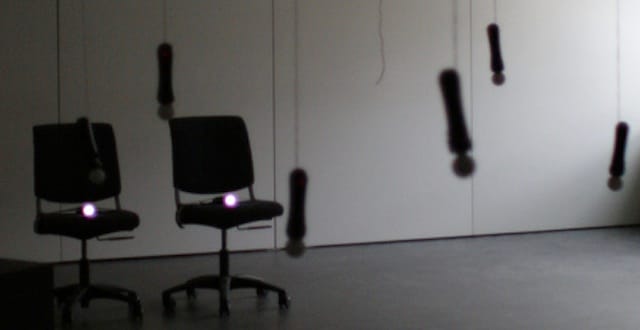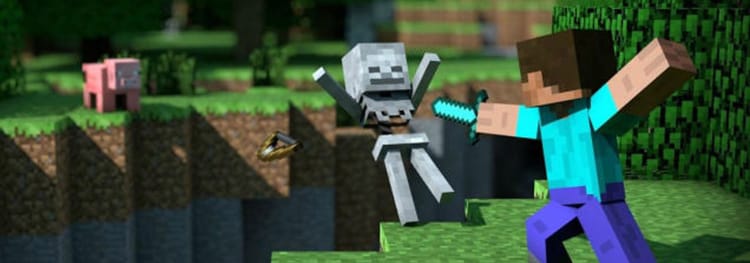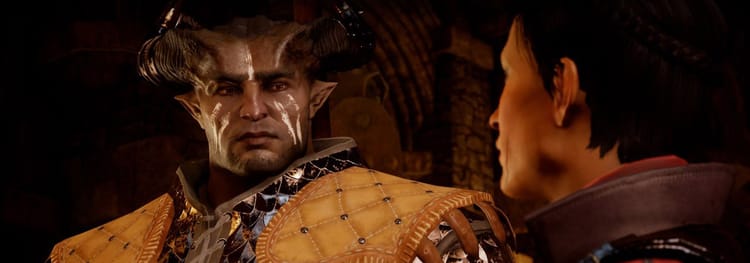Gaming’s Newest Grind

Designers rarely envision all possible uses for their creation, which are occasionally given a life of their own. Wily users have converted CDs into frisbees, mayonnaise into lubricant, and books into doorstops. Awkward Tarzan Grinding Game likewise finds an unexpected use for Sony’s PlayStation 3 Move controller. It’s a site-specific installation game created in 48 hours recently at IT University of Copenhagen for Nordic Game Jam, part of the more than 11,000-participant-strong Global Game Jam. Even in the game jam format, with its tendency toward unique and wacky games, Awkward Tarzan Grinding Game stands out by using the Move to create a new space for gameplay and by encouraging players to come into physical contact.
Watch this gameplay video first. Here’s what’s going on: Each player starts out in one of four corners, each with a different color. Players move by grabbing “vines,” the upside-down Move controllers hanging from the 4×5 grid. As long as any button on the controller is pressed, the vine is held. The vines randomly change color over time. When a player holds two vines at a time, they last about twice as long as normal. If no vines of a player’s color are held, he or she is eliminated. The last player standing wins.
In real play sessions, the lights are off and the jungle-themed soundtrack is turned up loud. So far, the killer strategy is finding two vines that allow you to absolutely obliterate your opponent’s personal space. As long as players keep hold of at least one vine of their color, there aren’t any rules regulating how they can interfere with the other players. Hips and pelvis become both offensive and defensive assets. Feet and legs get tangled up. One of the game’s creators hooked my elbow between his chin and chest to stop me from grabbing a desperately needed vine. Particularly unfortunate players fall prey to the “sandwich,” where two opponents hem in one victim and trap him by vigorously mashing themselves together. When this tactic is successful, as it often is, the defeated player is ushered out with a sound that is not quite “whomp-whomp” but decidedly in the same genre.
As the match goes on, the frequency of color changes increases and the game gets tenser. When players are eliminated, the Move controllers of their color go dim. Then there are two: a final duel in the dim glow of a dozen pulsing spheres of light alternating between the two remaining shades, two implacable foes swinging strategically from vine to vine before grinding all up on each other with a vim and gusto unmatched even at the most hormone-addled prom. The whomp-whomp sound rings out—one color disappears, and the final player standing wins. All the controllers blink with the hue of the sole survivor. Triumphant, the victor inevitably lifts their arms over way over their head in the classic fiero pose as cheerful music exalts their achievement. The twinkling lights serve as visual applause, like the riot of flashbulbs after a slugger knocks one out of the park.
/ / /
Awkward Tarzan Grinding Game was created and installed by Adam Henriksson (Umeå Institute of Design), Thomas Perl (Vienna University of Technology) and Doug Wilson (ITU-Copenhagen). Doug is a veteran of Move-based games and Nordic Game Jam; last year, he was part of the team that developed Johann Sebastian Joust, which went on to win the jam and was recently nominated for both the Independent Game Festival’s Nuovo Award and its Seumas McNally Grand Prize. Adam studies interaction design and competed in NGJ 2011. While Thomas hasn’t competed in NGJ before, the technology behind J.S. Joust was based on an open-source plug-in he released. From Oakland, Calif., David Kanaga, who recently worked on Proteus, contributed the superb soundtrack. To my ear, it has overtones of Donkey Kong Country and invokes the same kind of playful mood.
About 24 hours into the jam, the game’s working title was Jungle Fucking Chaos and it consisted of eight or nine Move controllers hanging from the ceiling, falling at various heights from head to mid-thigh. There were still only two players. At that point, Doug and Adam were trying to figure out if having the controllers at head height might be hazardous to players.
“Was player safety a consideration in B.U.T.T.O.N.?” Adam asks with a hint of mischief.

“No, of course not,” Doug reassures him facetiously. After all, the unabridged title of the game Doug developed with the Copenhagen Game Collective is Brutally Unfair Tactics Totally OK Now; it’s aptly named. They discuss moving the controllers down low, below waist height, to protect against any head-smacking. Doug thoughtfully reaches up and grabs a higher controller, aping a pensive Tarzan.
“This height is nice. You want to feel like you’re in a jungle,” he says. Each dynamic of the game gets the same careful treatment and many iterations, from the timing of the light pulses to the number of vines. Every few minutes, the team playtests a new variant, scrapping the changes that aren’t fun and building on the ones that are. They were originally going to use magnets, but it turns out getting rare earth magnets on short notice is tough and the magnetometer in the Move is complicated. That plan also originally called for players to have their arms tied to their sides so they would have to move the controllers by flailing their faces and torsos against the controller.
Some ideas don’t pan out. But along the way, a few foundational contributions are made to the nascent field of Move hacking: the maximum number of Moves connected to one computer turns out to be nine instead of seven, and the team creates a platform for integrating multiple computers to which Moves are connected. Not only does this allow 20 controllers to be in the grid, it means 18 or more players for J.S. Joust and other games. During the game jam they’re not only learning new techniques for themselves, they’re likely advancing the state of the art.
/ / /
By the end of the day, the game isn’t perfect. The Move controllers are hard to grab while pressing the buttons reliably, and not well shaped for being grabbed upside-down. After a few tense play sessions, my hands feel a little sore. Despite Doug’s careful planning, I take a rapidly accelerating Move controller to the bottom lip. Overenthusiastic players occasionally rip one of the vines out of the ceiling, or two occasionally get tangled up. There are also happy accidents: the grid of supporting ropes attached to the vine was originally in place to restrict the arc of a swinging Move, but it has the brilliant consequence of making any movement of one vine affect all the others, introducing a hypnotic swing to the 20 dots of light swirling around the players.
Hips and pelvis become both offensive and defensive assets.
During the NGJ after-party, 30 people crowd into the room to play and watch. Snatches of laughter and grunts stand out over the music. As soon as the blinking lights signaling victory fill the room, people surge up from the sides, grabbing controllers and starting a new game right away. With a room full of spectators, the true heart of the game is clear: with no digital graphics, no written rules, and no refs, a huge segment of play is left up to player interpretation. How hard can players jostle? Is kicking a controller so that it rocks back into your reach a legit play? What about knocking a controller out of someone’s hand? There’s no computer there to make the decisions clear and simple. Instead, players have to interpret ambiguity and take risks to discover or extend the boundaries of play.
My most serious critique of the game is the inaccuracy of its current working title. I don’t know what strange magic the grid of Moves possesses, but even while mashing bodies against complete strangers, the game never feels awkward. Almost everyone bellows their disappointment when they lose, because it’s so much fun pushing people around and desperately trying to snatch up a free vine; and the winners have a beatific glow that lasts even when their color stops flickering throughout the room. After three visits from the building’s security announcing that the floor is closing, the team has to kick eager players out so it can start tearing down the installation.
Photographs by Thomas Rousse



